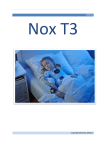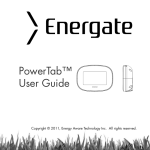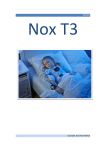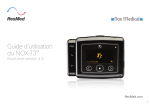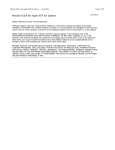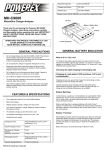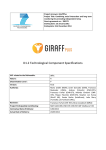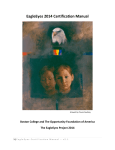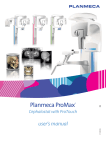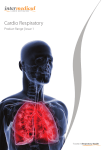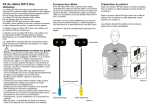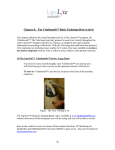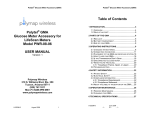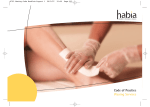Download Nox A1 Device Manual - Version 1.5 - EN
Transcript
MANUAL Copyright 2015 Nox Medical Nox A1 Manual Version 1.5 Latest Revision: March 2015 Copyright © 2015 Nox Medical - All rights reserved Manufactured by: Nox Medical ehf Katrinartuni 2 IS - 105 Reykjavik Iceland Website: www.noxmedical.com For distributor information go to: www.noxmedical.com Copyright Notice No part of this publication may be reproduced, transmitted, transcribed, stored in a retrieval system, or translated into any language or computer language, in any form, or by any means: electronic, mechanical, magnetic, optical, chemical, manual, or otherwise, without the prior written authorization from Nox Medical. Disclaimer This document may contain typographical errors or technical inaccuracies. Nox Medical does not accept any liability for the use or misuse whether direct or indirect of the products, or for damages arising out of the use of or inability to use the products. Users must accept all responsibility for any results obtained by or concluded from data obtained by the products including software from Nox Medical. All clinical conclusions and decisions that are based on the use of this product are the responsibility of the user. License Notice The Nox-A1 device software contains BIGDIGITS multiple-precision arithmetic code originally written by David Ireland, copyright © 2001-8 by D.I. Management Services Pty Limited <www.di-mgt.com.au>, and is used with permission. Nox A1 Manual Table of Contents Table of Contents ..................................................................................................................................... 3 Introduction .............................................................................................................................................. 5 Scope ................................................................................................................................................... 5 Warnings and Cautions for Use ........................................................................................................... 5 Device Description .................................................................................................................................... 7 Intended Use........................................................................................................................................ 7 Contraindications ................................................................................................................................. 7 A1 Interface ......................................................................................................................................... 8 Operating the Device .............................................................................................................................. 10 Connecting the A1 Device to a Computer ......................................................................................... 10 Configuring and Downloading from A1 Device .................................................................................. 10 Manually Starting/Stopping a Recording ........................................................................................... 11 Starting a Recording at a Scheduled Time ......................................................................................... 12 Signal and Status Checks .................................................................................................................... 13 Patient Hookup ....................................................................................................................................... 14 Inserting a Battery to the A1 Device .................................................................................................. 14 Attaching the A1 Device and the RIP Belts ........................................................................................ 16 Attaching the Nasal Cannula .............................................................................................................. 18 Measuring EEG Signals ....................................................................................................................... 19 Measuring EMG/ECG Signals ............................................................................................................. 21 Measuring Mask Pressure.................................................................................................................. 22 Measuring data from auxiliary devices .............................................................................................. 23 Measuring Pulse and Oxygen Saturation ........................................................................................... 23 Inserting Batteries into the Oximeter ................................................................................................ 24 Selecting Oximeter Sensor Size.......................................................................................................... 25 Attaching the Pulse Oximeter Module and Sensor ............................................................................ 26 Configure the Oximeter Setup ........................................................................................................... 28 Maintenance........................................................................................................................................... 29 ~3~ Nox A1 Manual Compatible Sensors and Devices ............................................................................................................ 31 Specifications .......................................................................................................................................... 36 A1 Device ........................................................................................................................................... 36 Material Information ......................................................................................................................... 38 Battery Information ........................................................................................................................... 39 Regulatory Information .......................................................................................................................... 40 Performance Testing and Validation Summary ................................................................................. 40 Classifications .................................................................................................................................... 40 Description of Symbols and Abbreviations ........................................................................................ 40 Bluetooth® Wireless Technology ....................................................................................................... 42 EMC Information ............................................................................................................................... 42 ~4~ Nox A1 Manual Introduction Congratulations on choosing the new Nox A1 portable PSG recorder. The A1 is an AASM (American Academy of Sleep Medicine) compliant PSG recorder and can be used for online and ambulatory sleep testing polysomnography (PSG). The device is compact, lightweight and easy to use. Simple sensor placement makes setup quick and easy. Scope This manual covers the A1 device and its components along with external sensors and devices that have been validated with the A1 system. It does not cover the software application needed for device configuration, data download, review and/or analysis. Warnings and Cautions for Use The device is NOT CERTIFIED TO BE USED FOR CONTINUOUS MONITORING where failure to operate can cause injuries or death of the patient. The term CONTINUOUS MONITORING is specified in the standard IEC 60601-1. Caution: U.S. Federal law restricts this device to sale by, or on the order of, a physician. This device complies with the international standard IEC 60601-1-2 for electromagnetic compatibility for medical electrical equipment and/or systems. This standard is designed to provide reasonable protection against harmful interference in a typical medical installation. However, because of the proliferation of radio-frequency transmitting equipment and other sources of electrical noise in healthcare and other environments, it is possible that high levels of interference due to close proximity or strength of source might disrupt the performance of the device. Medical electrical equipment needs special precautions regarding EMC, and all equipment must be installed and put into service according to information detailed in the EMC Information section of this manual. The A1 device is designed to be safe for use for pacemaker patients as long as the pacemakers comply with the EN 50061 standard of electrical safety of medical devices. The operator should consult the accompanying documents of the pacemaker regarding its certifications and requirements of use or, if necessary, contact the producer. The A1 device is not defibrillator proof. The A1 device is not intended to be used with high frequency (HF) equipment The device is classified as an ordinary equipment regarding ingress of liquids, i.e. it is NOT drip-proof, splash-proof or watertight. The device is NOT suitable for use in presence of a FLAMMABLE ANESTHETIC MIXTURE WITH AIR or WITH OXYGEN or NITROUS OXIDE. The A1 head cable/EEG cup sets do not provide protection against the effect of the discharge of a cardiac defibrillator nor against high- frequency burns Warning/caution: Do not use the A1 System during radiography/X-ray studies As with all medical equipment, carefully route cables and connections to reduce the possibility of entanglement or strangulation. Do not use any part of the A1 system, including patient cables and electrodes, in an MRI (Magnetic Resonance Imaging) environment. The A1 device and RIP belts should be worn over clothing. WARNING: Do not use damaged equipment, sensors or accessories. The A1 device and its accessories should be removed from the patient before download of data. ~5~ Nox A1 Manual There are no user serviceable parts inside the A1 device. The A1 device should be serviced by authorized parties only. The warranty is void if the A1 device is opened. WARNING: No modification of this equipment is allowed. To avoid risk of battery leakage, the A1 device should not be stored with a battery inserted in the battery compartment. External equipment intended for connection to signal input, signal output or other connectors shall comply with the relevant product standard e.g. IEC 60950-1 for IT equipment and the IEC 60601-series for medical electrical equipment. In addition, all such combinations – systems – shall comply with the safety requirements stated in the collateral standard IEC 60601-1-1 or the general standard IEC 60601-1, edition 3, clause 16. Any equipment not complying with the leakage current requirements in IEC 60601-1 shall be kept outside the patient environment i.e. at least 1.5 m from the patient support. Any person who connects external equipment to signal input, signal output or other connectors has formed a system and is therefore responsible for the system to comply with the requirements. If in doubt, contact qualified medical technician or your local representative. The A1 system is only to be operated by skilled health care professionals. The A1 device and accessories should be removed from patient before use of the USB connector. The USB connector shall only be used for the purposes of configuring the device and downloading data from the device. WARNING: Avoid accidental contact between connected but unused APPLIED PARTS and other conductive parts including those connected to protective earth. WARNING/CAUTION: Electrodes should only be used by or in consultation with a health care provider familiar with their proper placement and use. WARNING/CAUTION: The electrodes should be applied only to intact, clean skin (e.g. not over open wounds, lesions, infected or inflamed areas). The Nox 5 Lead EEG Electrode Cables should be properly disposed of if they cannot be fully cleaned between uses The Nox 5 Lead EEG Electrode Cables are not certified to be used for electrical stimulation purposes. Please read this manual carefully before use, especially sections marked with an exclamation mark. ~6~ Nox A1 Manual Device Description The Nox A1 device is an AASM compliant PSG recorder. The A1 input channels and built-in capabilities include the following: 13 unipolar channels; for recording of EEG, EOG and submental EMG 1 ground channel 4 bipolar channels; for recording of ECG, EMG – LM, bruxism or additional EMG 1 pressure/cannula channel; for recording of nasal or mask pressure 2 respiratory effort channels; for recording of abdomen and thorax effort 3-D built-in acceleration sensor; for recording of patient’s position and activity Built-in microphone; for recording of audio and snoring Built-in Bluetooth module; to support wireless connectivity allowing it to record signals from compatible auxiliary devices The Bluetooth function also allows wireless streaming of data for online review of signals. The device is powered with one AA battery. Intended Use The Nox A1 device is intended for recording of physiological signals during sleep. The A1 device is intended for patients greater than 2 years of age. The intended environments are hospitals, institutions, sleep centers, sleep clinics, or other test environments, including the patient’s home. Contraindications The A1 device is NOT intended for any patient monitoring or automatic diagnosis. ~7~ Nox A1 Manual A1 Interface The A1 device interface consists of a display, buttons, sensor inputs/connections and a USB connector. The USB connector is placed under the battery lid and connects to a mini USB cable for device configuration and data download. See the figures and tables below for detailed description. NUMBER FUNCTION 1 Display 2 Push button – Middle 3 Push button – Forward 4 Push button – Backward 5 Clip strap loops 6 Microphone – For recording of respiratory sounds 7 Indicator light for device status 8 Pressure lock – Connects to nasal cannula/mask pressure tube 9 Unipolar touch proof inputs 10 Reference ground input 11 Bipolar touch proof inputs 12 Battery lid – Covers the battery and the USB connector ~8~ Nox A1 Manual 13 Battery lid pin 14 Metal snaps – Connects to thorax RIP belt 15 Metal snaps – Connects to abdomen cable ~9~ Nox A1 Manual Operating the Device The A1 device is operated with three push buttons located on the front panel. Pressing the Middle button turns on the display. The display will automatically turn off in 3 minutes. Connecting the A1 Device to a Computer To connect an A1 device to a computer you need to access the USB connector on the device. The USB connector is placed under the battery lid making it inaccessible and tamper proof for children. To open the battery lid, press with a pen or a similar tool, available from Nox Medical, on the battery lid pin and slide the battery lid down, towards the bottom of the device. The A1 device connects to the computer by using a mini USB cable. The battery does not have to be inserted while the device is connected to the computer. When the A1 device is connected to the computer the device display lights up. Configuring and Downloading from A1 Device To download a recording or configure the A1 device you will need to start the Noxturnal software application and connect the device to the computer. Please refer to the applicable software user manual for more information on how to perform those tasks. When you are done working with the device eject the device from the Noxturnal software and unplug the mini USB cable. Insert the battery and close the battery compartment by pressing the lid back towards the device without causing any strain, then slide it back into position, towards the top of the device. ~ 10 ~ Nox A1 Manual Manually Starting/Stopping a Recording If the device has been configured to start the recording manually, you can use the Middle button to manually start a recording. Pressing the middle button turns on the display. The device will instruct you to “Hold middle button down to start recording”. Please do so until you see “Recording Duration” displayed. Note the Middle button needs to be pressed down for approximately 4-5 s before “Recording Duration” displays. At this point the device has started to record data. After the display turns off, the light on the top right side of the display will blink intermittently indicating that recording is taking place. Use the same method to manually stop the recording. If the duration of the recording has been specified during configuration, the recording will automatically stop after the specified duration. ~ 11 ~ Nox A1 Manual Starting a Recording at a Scheduled Time If the device has been configured to automatically, start a recording at a scheduled time there are no actions required for the recording to start. Pressing the Middle button before the recording has started will display a countdown to the specified start time of the recording. If the recording has begun, the display shows the current duration of the recording. ~ 12 ~ Nox A1 Manual Signal and Status Checks The indicator light on the device blinks green when a recording is in progress and the device is functioning normally. When there are any device warnings the indicator light blinks orange. Warnings might include: Battery low Information about the recording and the device is shown on the display. If the display is turned off, pressing the Middle button turns it on. The display will turn itself off again after being inactive for 3 minutes. 1. 2. On the top right corner is a battery indicator which shows the battery status. The battery indicator shows 100% when the device has fresh batteries. Duration being displayed. If the Bluetooth symbol is not visible, press the small button at the top of the oximeter and hold it down for 3 seconds or until the Bluetooth symbol appears on the screen. For detailed signal checks, please refer to the Noxturnal App, available on the Google Play® store. ~ 13 ~ Nox A1 Manual Patient Hookup The A1 system is only to be operated by skilled health care professionals. A trained clinician should perform the hookup of A1 system to the patient using the instructions provided in this manual. If the patient is supposed to start the recording at home, the clinician trains the user how to do so. Do not use damaged equipment, sensors or accessories. As with all medical equipment, carefully route cables and connections to reduce the possibility of entanglement or strangulation. Always use fully charged or fresh battery for each sleep recording. Inserting a Battery to the A1 Device Before you start a recording you should make sure that the device has new or fully charged battery. To insert a new battery do the following: 1. Open the battery compartment by pressing down the battery lid pin with the Nox Lid Key or similar tool and slide the lid towards the bottom of the device. 2. Place one AA battery in the compartment aligning the battery poles as illustrated on the back of the device (the positive (+) pole is towards the battery lid). 3. Close the battery compartment by pressing the lid back towards the device without causing any strain, then slide it back into position, towards the top of the device. Make sure the lid is securely closed. The status of the battery can be checked by turning on the device. The battery status indicator positioned in the upper right-hand corner of the device display allows you to check the battery status. When the battery is running low during a recording the device will automatically stop the recording. ~ 14 ~ Nox A1 Manual Always use fully charged Powerex 2700 mAh Rechargeable Batteries or fresh lithium battery for each sleep recording. All lithium batteries used with the A1 device shall be according to the standard IEC 60086-4 Primary batteries - Part 4: Safety of lithium batteries. ~ 15 ~ Nox A1 Manual Attaching the A1 Device and the RIP Belts Step 1 Snap the clips that are attached to the device to the patient’s shirt. 1 Step 2 to Step 4 Snap the abdomen cable to the back of the device. Place a RIP belt around the thorax and snap its ends to the back panel of the device. Adjust the cable length as needed by wrapping it around the abdomen connection unit. Place a RIP belt around the abdomen and snap in place. 2 3 4 Step 5 Attaching the device and respiratory sensors is now completed. 5 ~ 16 ~ Nox A1 Manual Adjusting the RIP Belts Disposable RIP Belts Fit the belts around the patient’s waist and thorax and adjust the length using the loop on each end to adjust the belt length such that the belt covers about two thirds of the patient’s circumference when the belt is unstretched. The length is fixed with hooks on the plastic connector of the belt. Refer to the section Compatible Sensors and Devices regarding the types of Nox RIP belts that have been validated with the A1 device. NOTE: For most patients the disposable RIP belts do not need to be adjusted if the correct belt size is chosen based on the patient’s abdomen circumference and/or body mass index (BMI). Belt size selection tables accompany the product for more detailed instruction. The A1 device and RIP belts should be worn over clothing. The RIP belts should fit the patient snugly without being uncomfortably tight. The disposable RIP belts are single use. The use of the same disposable RIP belt on more than one patient poses a risk of cross-infection. ~ 17 ~ Nox A1 Manual Attaching the Nasal Cannula Step 1 Place the nasal prongs gently in the nostrils. The prongs should point downwards inside the nostrils. 1 Step 2 Pull the cannula tubing over the ears and then position it under the chin. Step 3 Slide the fastener snugly under the chin to hold the cannula tubing securely in place. 1 2 3 NOTE: The Nox nasal cannula with filter has a built-in hydrophobic filter and is the preferred way to measure nasal airflow and snoring as it is designed to maximize the signal quality and fits directly with the A1 device. If it is preferred to use a non-filtered Luer-lock cannula, it is necessary to use a filter tube connector from Nox Medical to interface with the A1 device. Refer to the section Compatible Sensors and Devices regarding the types of nasal cannulas that have been validated with the A1 device. Medical tape can be used to hold the cannula against the cheeks to secure the cannula in place if necessary. The nasal cannula is single patient use. The use of the same nasal cannula on more than one patient poses a risk of cross-infection. ~ 18 ~ Nox A1 Manual Measuring EEG Signals Connect the Nox EEG Head Cable to the E2-E1, F4-F3, C4-C3, O2-O1, M2-M1 unipolar and ground inputs of the A1 device. Place a snap-on electrode on the middle of the patient´s forehead. Route the head cable behind the patients head and snap the cable to the electrode. Connect two Nox EEG 5 Lead Gold Electrode Cables to the head cable, one on each side. ~ 19 ~ Nox A1 Manual Attach the gold cup electrodes to the patient’s head. The green wire is for E1/E2, the blue wire is for F3/F4, the yellow wire is for C3/C4, the grey wire is for O1/O2 and the red wire is for M1/M2. For submental EMG, insert the electrode leads into the EMG channels of the device and attach the electrodes to the patient´s chin. The front chin electrode goes into the F input, the left chin electrode goes into the 1 input, and the right chin electrode goes into the 2 input. Make sure the skin is clean before attaching the electrodes. To avoid safety hazards: Make sure the conductive parts of electrodes and associated connectors, including the neutral electrode, do not contact other conductive parts including earth. The Nox 5 Lead EEG Electrode Cables should be properly disposed of if they cannot be fully cleaned between uses. The Nox 5 Lead EEG Electrode Cables are not certified to be used for electrical stimulation purposes. Note: The Nox EEG Head Cable is available in both pediatric and adult lengths. ~ 20 ~ Nox A1 Manual Measuring EMG/ECG Signals The A1 device is equipped with 4 bipolar channels suitable for recording of ECG and EMG signals such as leg EMG or masseter EMG for bruxism detection. The device´s bipolar channels are labeled with GP1, ECG, LM1, and LM2 and connect to bipolar electrode leads with keyhole connectors. However, during recording setup, those channels can be defined for any EMG/ECG signals. Please refer to the applicable software user manual for more information on how to configure the device. The figure below shows connections for ECG, EMG on right leg and EMG on left leg. When not using the Nox EEG Head Cable you can connect your ground electrode to the PGND input on the device. Make sure the skin is clean before attaching the electrodes. To avoid safety hazards: Make sure the conductive parts of electrodes and associated connectors, including the neutral electrode, do not contact other conductive parts including earth. ~ 21 ~ Nox A1 Manual Measuring Mask Pressure A mask pressure tube is used for connection to CPAP masks for measuring mask pressure. The pressure tube connects to the pressure lock on the A1 device via a filter tube connector from Nox Medical. Refer to the section Compatible Sensors and Devices regarding the types of mask pressure tubes that have been validated with the A1 device. The mask pressure tube is single patient use. The use of the same mask pressure tube on more than one patient poses a risk of cross-infection. The mask pressure tube can only be connected to the pressure lock on the A1 device by using the Nox filter tube connector. The filter tube connector is single patient use. ~ 22 ~ Nox A1 Manual Measuring data from auxiliary devices The A1 device is able to communicate with auxiliary devices over a Bluetooth® link with the Nox W7 Link. Refer to the user instructions accompanying the Nox W7 Link package regarding the types of auxiliary devices that have been validated with the A1 device. The A1 device is NOT CERTIFIED TO BE USED FOR CONTINUOUS MONITORING where failure to operate can cause injuries or death of the patient. Measuring Pulse and Oxygen Saturation The A1 device is able to communicate with an external Bluetooth® pulse oximeter for recording of oxygen saturation levels (SpO2), pulse rate, and plethysmography data. Refer to the section Compatible Sensors and Devices regarding the types of pulse oximeters that have been validated with the A1 device. The A1 device is NOT CERTIFIED TO BE USED FOR CONTINUOUS MONITORING where failure to operate can cause injuries or death of the patient. To avoid the risk of confusing or misinterpreting patient data verify that the patient module is paired with the correct A1 device. The pulse oximetry system might misinterpret motion as good pulse quality. Minimize finger motion or change the type of sensor being used. Do not fasten the pulse oximeter too tightly around the wrist. Inaccurate readings and patient discomfort could result. To prevent the sensor from falling off secure the wire to the digit with medical tape. Do not use a damaged sensor. If the sensor is damaged in any way, discontinue use immediately and replace the sensor. To prevent improper performance and/or patient injury, verify the sensor and pulse oximeter compatibility before use. Factors that may degrade pulse oximeter performance include the following: excessive ambient light excessive motion electrosurgical interference arterial catheter blood pressure cuffs infusion lines moisture in the sensor improperly applied sensor carboxyhemoglobin methemoglobin artificial nails incorrect sensor type ~ 23 ~ Nox A1 Manual poor pulse quality venous pulsations anemia or low hemoglobin concentrations cardiovascular dyes sensor not at heart level dysfunctional hemoglobin fingernail polish Refer to 3rd party instructions for use accompanying the pulse oximeter and/or oximeter sensor for maximum oximeter application time at a single site. Refer to 3rd party instructions for use accompanying the pulse oximeter and oximeter sensor for additional warnings and cautions. Inserting Batteries into the Oximeter Nonin 3150 Pulse Oximeter Refer to the 3rd party accompanying instructions regarding replacement of batteries when using the Nonin 3150 oximeter. Single use batteries last up to 48 hours of use so it is important to track the number of measurements made with the Nonin 3150 pulse oximeter. It is recommended to change the batteries after 2-3 recordings depending on the quality of the batteries being used. If you are using rechargeable batteries, it is recommended that you replace them before every recording. ~ 24 ~ Nox A1 Manual Selecting Oximeter Sensor Size Soft Sensor Soft sensor size recommendations are based on digit height (thickness). The digit height (H) is measured as shown in the figure below. For digit height from 7.5 mm (0.3 in) to 12.5 mm (0.5 in), size small should be selected. For digit height from 10.5 mm (0.4 in) to 19.0 mm (0.7 in), size medium should be selected. For digit height from 12.5 mm (0.5 in) to 25.5 mm (1.0 in), size large should be selected. Choosing the Sensor Application Site The preferred application site for patients over 20 kg is the index finger. However, other fingers or toes may be used where the tissue thickness is between 5 and 21 millimeters. Other sites may not give acceptable results because of inadequate light transmission or perfusion. ~ 25 ~ Nox A1 Manual Attaching the Pulse Oximeter Module and Sensor Nonin 3150 Pulse Oximeter Step 1 to Step 4 1. 2. 3. 4. Separate the short end of the wristband from the long end. Insert the short end in the loops on the oximeter. Place the probe wire between the short and long end of the wristband. Attach the long end to the short end to secure the wristband on the oximeter. The oximeter is now securely placed on the wristband. 1 ~ 26 ~ Nox A1 Manual Step 5 to Step 6 5. 6. 5 Place the wristband around the patient’s wrist. Put the probe on the finger. 6 ~ 27 ~ Nox A1 Manual Configure the Oximeter Setup Establish Connection between the Nonin 3150 Oximeter and A1 R ecorder Use the Noxturnal software or Noxturnal App to establish the connection between the Nonin 3150 Oximeter and A1 Recorder. The connection is established by entering the Bluetooth (BDA) address of the oximeter in the recording configuration. ~ 28 ~ Nox A1 Manual Maintenance The A1 device and accessories should be stored in a clean, dry place. Handle the A1 device with care and protect it against mechanical shocks, dirt and liquids. The device is not waterproof or splash proof. To update the A1 device you will need the Noxturnal software running on the computer which the device is connected to. Please refer to the applicable software user manual for more information on how to perform this task. No regular testing of the A1 device or accessories, including patient cables, is needed. Remove batteries from the A1 device if the device is not used within 30 days. The A1 device has an internal battery which is automatically charged by regular use. It is recommended to charge the internal battery before the first use or if the device has not been in use for three months or more. The battery is charged by plugging the device to a computer with a USB cable for 6 hours or more. It is never recommended to downgrade the firmware of the A1 device. Downgrading the firmware will result in losing the calibration for the device: calibration values will be replaced with default values that might affect the pressure and impedance signals being recorded. Environmental Conditions Temperature Operation: +5 °C to +50 °C (40 °F to 120 ° F) Storage: -20 °C to +50 °C (0 °F to 120 ° F) Relative Humidity Operation: 15-95% (non-condensing) Storage: 10-95% (non-condensing) Pressure Withstands atmospheric pressures from 700 hPa to 1060 hPa Calibration The A1 device is factory calibrated. No further calibration is needed. ~ 29 ~ Nox A1 Manual Cleaning All reusable components should be cleaned between each patient use. Clean the A1 device with a soft cloth dampened with hospital grade cleaner that is not corrosive to plastic or metal. Do not pour or spray any liquids onto the device, and do not allow any liquids to enter any openings on the device. Allow the unit to dry thoroughly before use. All Nox cables used with the A1 device are reusable. Clean the cables with a moist cloth using hospital grade cleaner. Do not immerse the cables in liquid and avoid contact of the cleaning solution with the connectors. Clean the carry case with a moist cloth using water or mild soap solution. Clean the gold cup electrode cables with alcohol free soap. A toothbrush can be used to scrub the electrodes to remove paste and debris. Be careful to not scrub too aggressively to avoid deterioration of the gold plating. For disinfection of the A1 device, Nox cables and gold cup electrodes the following materials may be used: Sodium hypochlorite diluted with water at 1:500 (bleach) 70-90% isopropanol Super Sani-Cloth Plus disinfection wipes The disposable RIP belts are single patient use ONLY. The Nox nasal cannulas and filter tube connector are single patient use ONLY. Clean the device separately from its associated sensors. Do not autoclave or immerse any device equipment or sensor in any kind of liquid. Do not use caustic or abrasive cleaning agents on the units. The Nox A1 components are NOT intended to be sterilized. Reusing single-use products on more than one patient poses a risk of crossinfection. Regarding cleaning/disinfection and re-use of 3rd party components and 3rd party sensors refer to the applicable 3rd party accompanying instructions. Disposal Follow local governing ordinances and recycling instructions regarding disposal or recycling of this device and accessories, including batteries. According to the regulation in Europe on Waste of Electrical and Electronic Equipment (WEEE) the components labeled with this symbol may not be disposed of as unsorted municipal waste. The components shall be collected separately and returned to the appropriate collection system available. Please contact your distributor regarding take-back or recycling of the components. ~ 30 ~ Nox A1 Manual Compatible Sensors and Devices The following table includes information on accessories, sensors and devices that have been validated with the A1 device. To ensure patient safety and effective use of the A1 device, only use accessories that have been validated for use by Nox Medical. The items listed below are Nox products and have been validated for use with the A1 device: NOX RIP BELTS Type Catalog Number Nox RIP Belts Disposable, Extra Large 14 sets 551050 Nox RIP Belts Disposable, Large 20 sets 551040 Nox RIP Belts Disposable, Medium 20 sets 551030 Nox RIP Belts Disposable, Small 20 sets 551020 Nox RIP Belts Disposable, Pediatric 20 sets 551010 NOX CANNULAS/FILTER TUBE CONNECTORS Type Catalog Number Nox Cannula with filter, 40 units 552010 Nox Cannula with Luer-lock, 50 units 552020 Nox Filter Tube Connector, 50 units 552110 A1 SYSTEM COMPONENTS Type Catalog Number Nox Abdomen Cable 562010 Nox USB Cable 562011 Nox A1 EEG Head Cable, Adult 90 cm 562110 Nox A1 EEG Head Cable, Pediatric 70 cm 562111 Nox A1 Carry Case 568011 Nox Service Kit 569010 Nox Battery Lid 569011 ~ 31 ~ Nox A1 Manual Nox Clip Strap 569013 Nox Lid Key 569014 UNIPOLAR SNAP-ON LEADS Type Catalogue Number Nox Snap-on Lead 50 cm, white, 1.5mm connector, 2 units 554020 Nox Snap On Lead 30 cm, beige-white, 1.5 mm connector, 2 units 554021 Nox Snap On Lead 100 cm, green, 1.5 mm connector, 1 unit 554022 Nox Snap On Lead 50 cm, beige-green, 1.5 mm connector, 1 unit 554023 Nox Snap On Lead 150 cm, grey, 1.5 mm connector, 2 units 554024 Nox Snap On Lead 100 cm, beige-grey, 1.5 mm connector, 2 units 554025 Nox Snap On Lead 150 cm, black, 1.5 mm connector, 2 units 554026 Nox Snap On Lead 100 cm, beige-black, 1.5 mm connector, 2 units 554027 Nox Snap On Lead 100 cm, orange, 1.5 mm connector, 2 units 554028 BIPOLAR SNAP-ON LEADS Type Catalogue Number Nox Snap On Double-Lead 50/100 cm, orange, keyhole connector, 1 unit 554310 Nox Snap On Double-Lead 30/50 cm, beige-orange, keyhole connector, 1 unit 554311 Nox Snap On Double-Lead 148/150 cm, grey, keyhole connector, 1 unit 554312 Nox Snap On Double-Lead 98/100 cm, beige-grey, keyhole connector, 1 unit 554313 Nox Snap On Double-Lead 148/150 cm, black, keyhole connector, 1 unit 554314 Nox Snap On Double-Lead 98/100 cm, beige-black, keyhole connector, 1 unit 554315 Nox Snap On Double-Lead 50/52 cm, white, keyhole connector, 1 unit 554316 Nox Snap On Double-Lead 30/32 cm, beige-white, keyhole connector, 1 unit 554317 ~ 32 ~ Nox A1 Manual GOLD CUP ELECTRODES Type Catalogue Number Nox Standard Gold Cup Electrode, 10 units 554410 Nox A1 EEG 5 Lead Electrode Cable 554411 BLUETOOTH LINK Type Catalogue Number Nox W7 Link Kit - S 544010 Nox W7 Link Kit - R 544011 ONLINE SETUP Type Blue Giga online module Catalogue Number 544022 MOBILE APP Type Noxturnal Mobile App, available from Google Play Store Catalogue Number 536210 The items listed below are 3rd party products and have been validated for use with the A1 device: PULSE OXIMETERS Type NONIN 3150 Catalogue Number 541010 PULSE OXIMETER ACCESSORIES Type Catalogue Number WristOx2 Soft Sensor – Small 553010 WristOx2 Soft Sensor – Medium 553020 WristOx2 Soft Sensor – Large 553030 WristOx2 Wrist Band 564042 ~ 33 ~ Nox A1 Manual DIFFERENTIAL PRESSURE SENSOR Type Differential Pressure Sensor Kit Catalogue Number 547010 FLOW SENSORS Type Catalogue Number Thermal Flow Sensor - Adult 552230 Thermal Flow Sensor – Pediatric 552231 MASK PRESSURE TUBING Type Catalogue Number Mask tubing 183cm (72in) Male x Male, 50 units 552310 Mask tubing 183cm (72in) Female x Male, 50 units 552320 ELECTRODES Type Catalogue Number Lead with Attached Electrode 100 cm, 1.5 mm connector, 10 units 554109 Lead with Attached Electrode 152 cm, 1.5 mm connector, 10 units 554110 Lead with Attached Electrode 50 cm, 1,5 mm connector, 12 units 554111 Snap on Electrode Disposable, small 25 units 554209 Blue Sensor® Snap on Electrode, 50 units 554210 ELECTRODE APPLIANCES Type Catalogue Number Nuprep ECG & EEG Abrasive Skin Prepping Gel, 4oz (114g), 3 units 555010 Ten20 Conductive EEG Paste, 4oz (114g), 3 units 555020 EC2 Electrode Cream, 3.5oz (100g), 1 unit 555030 ~ 34 ~ Nox A1 Manual CLEANING Type Super Sani-Cloth Plus Disinfection Wipes Catalogue Number 559010 ~ 35 ~ Nox A1 Manual Specifications A1 Device DESCRIPTION PROPERTIES FUNCTION Storage Capacity 1GByte Recording Time 8 hours Internal Channels Two RIP Respiratory Effort Pressure Respiratory sound/snoring Four bipolar Thirteen unipolar Position Activity Oximeter data via Bluetooth Capnography data via Bluetooth CPAP data via Bluetooth A1 Device Dimensions 82 mm (3.2”) W, 63 mm (2.5”) H, 21 mm(0.85”) D A1 Weight 132 g (163 g with battery) (0.29 lbs (0.36 lbs with battery)) A1 Bipolar Inputs Touch proof 1mm keyhole connector Input range ±8mV AC Bandwidth 0.1 - 85Hz Input impedance >5MOhm Sampling Rate = 256kHz Storage rate = 200 Hz Touch proof DIN 42-802 Input range ±3.2mV AC Bandwidth 0.1 - 85Hz Input impedance >5MOhm Sampling Rate = 256kHz Storage rate = 200 Hz External Channels PHYSICAL A1 Unipolar Inputs ~ 36 ~ Nox A1 Manual Abdomen Cable Length Nox USB Cable 50 cm (19.7”) Type of USB connector at device end: Mini-B Type of USB connector at PC end: Standard A Hydrophobic Filter with Female Luer-lock inlet - diameter of 13 mm (0.51”), with a 0.45 μ filtering capability One 1.5 V AA battery Host PC (data configuration and download) Lithium Powerex 2700 mAh Rechargeable Batteries Type OLED Display Dimensions 19 mm x 35 mm Resolution 128 dots x 64 dots Bluetooth® Compliance Version 2.0 Operating Frequency 2.402-2.480 GHz Output Power < 1.62 mW Network Topology Point-to-Point: Point-to-Multipoint Operation Scatter-Net Master Antenna Type Internal Modulation Type Frequency Shift Keying/Frequency Hopping Spread Spectrum Bandwidth 1 MHz Filter Tube Connector POWER Power Source Battery Type DISPLAY Transmitter ~ 37 ~ Nox A1 Manual Material Information COMPONENT MATERIAL CONTENT Enclosure: PC Proxy: PC/ABS Snaps: Gold plated stainless steel Display/Keypad: PET Clips: Polyester/Steel Cable Jacket: PVC Connector: ABS/PC Snaps: Stainless steel Cable Jacket: PVC Connector: PVC/Steel Snap on electrode cables, Cable Jacket: PVC Bipolar Connector: Keyhole connector Wire Material: Tinsel Snap: Nickel plated brass socket Snap on electrode cables, Cable Jacket: PVC Unipolar Connector: Unipolar connector Wire Material: Tinsel Snap: Nickel plated brass socket Cable Jacket: PVC Connectors: Touch proof connector/Dual USB micro receptacles Snap: Nickel plated brass socket EEG 5 Lead Gold Electrode Cable Jacket: Teflon Cables Connector: USB micro connector 10 mm diameter gold plated cup electrodes External Part: Polypropylene Internal Part: PE foam Belt Elastic: Polyester/Dorlastan Connector: ABS Belt Wire: Tin plated copper A1 Device Abdomen Cable USB Cable EEG Head Cable Carry Case Disposable RIP Belts ~ 38 ~ Nox A1 Manual The Nox A1 components and Nox sensors addressed in this manual are not made with natural rubber latex. Battery Information The list below is provided to assist the user in selecting the appropriate battery type for the A1 study: Lithium batteries and Powerex 2700 mAh Rechargeable Batteries can be used to record up to 8 hours. NOTE: The recording durations listed above depend on the quality of the batteries used. It is recommended to use fully charged or fresh battery for each sleep study. All lithium batteries used with the A1 device shall be according to the standard IEC 60086-4 Primary batteries - Part 4: Safety of lithium batteries. ~ 39 ~ Nox A1 Manual Regulatory Information Performance Testing and Validation Summary The Nox A1 system has been tested and verified in various phases to include internal testing, verification and validation as well as external testing to assure product safety, effectiveness and reliability. The design was verified and validated, including clinical evaluation, throughout the design process, according to requirement specifications and intended use. An external accredited test house was used to conduct testing needed to comply with the applicable standards regarding EMC and patient safety as well as additional RF testing to assure compliance to R&TTE. Nox Medical holds a CMDCAS ISO 13485:2003 certified Quality Management System which complies with the requirements of the Medical Device Directive (MDD), FDA Quality System Regulation (QSR) and Canada Medical Device Regulations (CMDR). Classifications Degree of protection (applied part) against electric shock: The device is classified as of type BF (see symbol to the left). Installation/use of the device: The device is classified as a portable device. Powering of the device: The device is internally powered equipment. Degree of protection against ingress of liquids: The device is classified as an ordinary equipment regarding ingress of liquids, i.e., it is not drip-proof, splashproof or watertight. Method of sterilization/disinfection: The device is not delivered sterile or intended to be sterilized. Use with flammable anesthetics: The device is not suitable for use in presence of a FLAMMABLE ANESTHETIC MIXTURE WITH AIR or WITH OXYGEN or NITROUS OXIDE. Mode of operation: The device is intended for CONTINUOUS OPERATION. Description of Symbols and Abbreviations Consult instructions for use Manufacturer information Date of manufacture Do not re-use Serial number ~ 40 ~ Nox A1 Manual Batch code Catalogue number Type BF applied part (patient isolation from electrical shock) This product is not made with natural rubber latex In compliance with the European Directive on Waste of Electrical and Electronic Equipment (WEEE) 2002/96/EC, do not dispose of this product as unsorted municipal waste Non ionizing electromagnetic radiation. Equipment includes RF transmitter: interference may occur in the vicinity of equipment marked with this symbol CE marking indicating conformance to EC directive 93/42/EEC and 2007/47/EC concerning medical devices Nox A1 Brand name/Model name APSG1EU Technical name REV Revision of device PGND Patient ground PRES Pressure input connector GP1 General purpose bipolar input connector E2-E1 F4-F3 C4-C3 Electroencephalography (EEG) and electrooculography (EOG) input connectors O2-O1 M2-M1 ECG Electrocardiography (ECG) input connector EMG: F, 1, 2 Electromyography (EMG) input connectors LM1 Leg electromyography (EMG) for limb movement (LM) detection input connectors LM2 ~ 41 ~ Nox A1 Manual Bluetooth® wireless technology Temperature limitation Humidity limitation Atmospheric pressure limitation Keep away from rain Fragile, handle with care Bluetooth® Wireless Technology The A1 device uses Bluetooth® wireless technology to receive signals from external Bluetooth modules. The Bluetooth wireless technology is based on a radio link that offers fast and reliable transmission of data. Bluetooth radio uses globally available frequency range in the ISM band, intended to ensure communication compatibility worldwide and a fast acknowledgement and frequency-hopping scheme to make the link robust, even in noisy radio environments. Please refer to the Specification section for details on RF specifications for the A1 device. EMC Information This product emits radio frequency (RF) energy, but the radiated output power of this device is far below the FCC radio frequency exposure limits. Nevertheless, the device should be used in such a manner that the potential for human contact with the antenna during normal operation is minimized. Caution: Exposure to radio frequency radiation. Portable and mobile RF communications can affect the performance of the device. The device should not be used adjacent to, or stacked with, other equipment. If adjacent or stacked use is necessary, the device should be observed to verify normal operation in the configuration in which it will be used. ~ 42 ~ Nox A1 Manual Electrostatic discharges (ESD) may cause artifacts in the signal from the device. Avoid conditions where electrostatic charge can build up because of low humidity and friction against carpets, clothing and sheets made from artificial fibers. The use of accessories, sensors, and cables other than those listed in this manual may result in increased emission and/or decreased immunity of this device. This system may be interfered with by other equipment, even if that equipment complies with CISPR emission requirements. Refer to the tables below in this section for specific information regarding the A1 device’s compliance to the standard IEC60601-1-2. Declaration of Conformity with USA Federal Communications Commission (FCC) and Canadian Ministry of Health Rules for Electromagnetic Compatibility The A1 device complies with Part 15 of the FCC Rules and RSS 210 of Industry Canada. Operation is subject to the following two conditions: 1. This device may not cause harmful interference, and 2. This device must accept any interference, including interference that may cause undesired operation of this device. For questions regarding your product or this FCC declaration, please contact: Fusion Sleep Therapy Services LLC 4265 Johns Creek Parkway, suite A, Suwanee, GA 30024, USA Phone: 678 990 3262/Fax: 678 990 3966 Email: [email protected] This equipment has been tested and found to comply with the limits for a Class B digital device, pursuant to Part 15 of FCC Rules. These limits are designed to provide reasonable protection against harmful interference in a residential installation. This equipment generates, uses, and can radiate radio frequency energy. If not installed and used in accordance with the instructions, it may cause harmful interference to radio communications. However, there is no guarantee that interference will not occur in a particular installation. If this equipment does cause harmful interference to radio or television reception, which can be determined by tuning the equipment off and on, the user is encouraged to try and correct the interference by one or more of the following measures: Reorient or relocate the receiving antenna. Increase the distance between the equipment and the receiver. Connect the equipment to outlet on a circuit different from that to which the receiver is connected. Consult the dealer or an experienced radio/TV technician for help. Modification Statement The FCC requires the user to be notified that any changes or modifications not expressly approved by Nox Medical could void the user’s authority to operate the equipment. ~ 43 ~ Nox A1 Manual Specific Absorption Rate (SAR) Ministry of Health (Canada), Safety Code 6: standards include substantial safety margin designed to ensure the safety of all persons, regardless of age and health. The Specific Absorption Rate or SAR is a measure of the rate at which electromagnetic energy is absorbed into the body. The SAR limit for the general public is 1.6W/kg for the trunk and 4W/kg for the limbs. Guidance and Manufacturer’s Declaration – Electromagnetic Emissions Guidance and manufacturer’s declaration – electromagnetic emissions The A1 device is intended for use in the electromagnetic environment specified below. The customer or the user of the device should assure that it is used in such an environment. Emissions test Compliance RF emissions CISPR 11 RF emissions CISPR 11 Harmonic emissions Electromagnetic environment – guidance Group 2 The A1 device must emit electromagnetic energy in order to perform its intended function. Nearby electronic equipment may be affected. Class B The A1 device is suitable for use in all establishments, including domestic establishments and those directly connected to the public low-voltage power supply network that supplies buildings used for domestic purposes. N/A IEC 61000-3-2 Voltage fluctuations/ flicker emissions N/A IEC 61000-3-3 Guidance and Manufacturer’s Declaration – Electromagnetic Immunity Guidance and manufacturer’s declaration – electromagnetic immunity The A1 device is intended for use in the electromagnetic environment specified below. The customer or the user of the device should assure that it is used in such an environment. Immunity test Electrostatic discharge (ESD) IEC 61000-4-2 IEC 60601 test level ±6kV contact ±8kV air Compliance level ±6kV contact ±8kV air Electromagnetic environment – guidance Floors should be wood, concrete or ceramic tile. If floors are covered with synthetic material, the relative humidity should be at least 30%. Power frequency (50/60Hz) magnetic field 3A/m 3A/m Power frequency magnetic fields should be at levels characteristic of a typical location in a typical commercial or hospital environment. IEC 61000-4-8 Portable and mobile RF communications equipment should be used no closer to any part of A1 device, ~ 44 ~ Nox A1 Manual including cables, than the recommended separation distance calculated from the equation applicable to the frequency of the transmitter. Recommended separation distance Conducted RF 3Vrms IEC 61000-4-6 150kHz to 80MHz Radiated RF 3 V/m IEC 61000-4-3 80MHz to 2.5GHz 3Vrms d = 1.2√P 3V/m d = 1.2√P 80MHz to 800MHz d = 2.3√P 800MHz to 2.5GHz where P is the maximum output power rating of the transmitter in watts (W) according to the transmitter manufacturer and d is the recommended separation distance in meters (m). Field strengths from fixed RF transmitters, as determined by an electromagnetic site survey,a should be less than the compliance level in each frequency range.b Interference may occur in the vicinity of equipment marked with the following symbol: NOTE 1: At 80MHz and 800MHz, the higher frequency range applies. NOTE 2: These guidelines may not apply in all situations. Electromagnetic propagation is affected by absorption and reflection from structures, objects and people. a Field strengths from fixed transmitters, such as base stations for radio (cellular/cordless) telephones and land mobile radios, amateur radio, AM and FM radio broadcast and TV broadcast cannot be predicted theoretically with accuracy. To assess the electromagnetic environment due to fixed RF transmitters, an electromagnetic site survey should be considered. If the measured field strength in the location in which the A1 device is used exceeds the applicable RF compliance level above, the A1 device should be observed to verify normal operation. If abnormal performance is observed, additional measures may be necessary, such as reorienting or relocating the A1 device. b Over the frequency range 150kHz to 80MHz, field strengths should be less than 3V/m. Recommended Separation Distance between Portable and Mobile RF Communications Equipment and the A1 Device Recommended separation distance between portable and mobile RF communications equipment and the A1 device The A1 device is intended for use in an electromagnetic environment in which radiated RF disturbances are controlled. The customer or the user of the device can help prevent electromagnetic interference by maintaining a minimum distance between portable and mobile RF communications equipment (transmitters) and the A1 device as recommended below, according to the maximum output power of the communications equipment. Rated maximum output power of transmitter[W] Separation distance according to frequency of transmitter [m] 150kHz to 80MHz 80MHz to 800MHz 800MHz to 2.5GHz ~ 45 ~ Nox A1 Manual d = 1.2√P d = 1.2√P d = 2.3√P 0.01 0.12 0.12 0.23 0.1 0.38 0.38 0.73 1 1.2 1.2 2.3 10 3.8 3.8 7.3 100 12 12 23 For transmitters rated at a maximum output power not listed above, the recommended separation distance d in meters (m) can be estimated using the equation applicable to the frequency of the transmitter, where P is the maximum output power rating of the transmitter in watts (W) according to the transmitter manufacturer. NOTE 1 At 80MHz and 800MHz, the separation distance for the higher frequency range applies. NOTE 2 These guidelines may not apply in all situations. Electromagnetic propagation is affected by absorption and reflection from structures, objects and people. ~ 46 ~














































